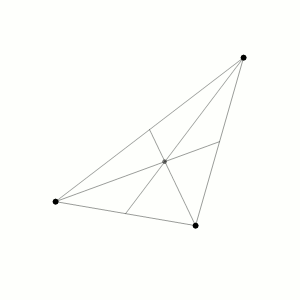|
Philosophiæ Naturalis Principia Mathematica
( English: ''Mathematical Principles of Natural Philosophy'') often referred to as simply the (), is a book by Isaac Newton that expounds Newton's laws of motion and his law of universal gravitation. The ''Principia'' is written in Latin and comprises three volumes, and was first published on 5 July 1687. The is considered one of the most important works in the history of science. The French mathematical physicist Alexis Clairaut assessed it in 1747: "The famous book of ''Mathematical Principles of Natural Philosophy'' marked the epoch of a great revolution in physics. The method followed by its illustrious author Sir Newton ... spread the light of mathematics on a science which up to then had remained in the darkness of conjectures and hypotheses." A more recent assessment has been that while acceptance of Newton's laws was not immediate, by the end of the century after publication in 1687, "no one could deny that" (out of the ) "a science had emerged that, at least in ... [...More Info...] [...Related Items...] OR: [Wikipedia] [Google] [Baidu] |
Isaac Newton
Sir Isaac Newton (25 December 1642 – 20 March 1726/27) was an English mathematician, physicist, astronomer, alchemist, theologian, and author (described in his time as a " natural philosopher"), widely recognised as one of the greatest mathematicians and physicists and among the most influential scientists of all time. He was a key figure in the philosophical revolution known as the Enlightenment. His book (''Mathematical Principles of Natural Philosophy''), first published in 1687, established classical mechanics. Newton also made seminal contributions to optics, and shares credit with German mathematician Gottfried Wilhelm Leibniz for developing infinitesimal calculus. In the , Newton formulated the laws of motion and universal gravitation that formed the dominant scientific viewpoint for centuries until it was superseded by the theory of relativity. Newton used his mathematical description of gravity to derive Kepler's laws of planetary motion, accoun ... [...More Info...] [...Related Items...] OR: [Wikipedia] [Google] [Baidu] |
Portrait Of Sir Isaac Newton, 1689
A portrait is a painting, photograph, sculpture, or other artistic representation of a person, in which the face and its expressions are predominant. The intent is to display the likeness, personality, and even the mood of the person. For this reason, in photography a portrait is generally not a snapshot, but a composed image of a person in a still position. A portrait often shows a person looking directly at the painter or photographer, in order to most successfully engage the subject with the viewer. History Prehistorical portraiture Plastered human skulls were reconstructed human skulls that were made in the ancient Levant between 9000 and 6000 BC in the Pre-Pottery Neolithic B period. They represent some of the oldest forms of art in the Middle East and demonstrate that the prehistoric population took great care in burying their ancestors below their homes. The skulls denote some of the earliest sculptural examples of portraiture in the history of art. Historical portraitu ... [...More Info...] [...Related Items...] OR: [Wikipedia] [Google] [Baidu] |
Three-body Problem
In physics and classical mechanics, the three-body problem is the problem of taking the initial positions and velocities (or momenta) of three point masses and solving for their subsequent motion according to Newton's laws of motion and Newton's law of universal gravitation. The three-body problem is a special case of the -body problem. Unlike two-body problems, no general closed-form solution exists, as the resulting dynamical system is chaotic for most initial conditions, and numerical methods are generally required. Historically, the first specific three-body problem to receive extended study was the one involving the Moon, Earth, and the Sun. In an extended modern sense, a three-body problem is any problem in classical mechanics or quantum mechanics that models the motion of three particles. Mathematical description The mathematical statement of the three-body problem can be given in terms of the Newtonian equations of motion for vector positions \mathbf = (x_i, y_i, z_i) ... [...More Info...] [...Related Items...] OR: [Wikipedia] [Google] [Baidu] |
Solar System
The Solar System Capitalization of the name varies. The International Astronomical Union, the authoritative body regarding astronomical nomenclature, specifies capitalizing the names of all individual astronomical objects but uses mixed "Solar System" and "solar system" structures in theinaming guidelines document. The name is commonly rendered in lower case ('solar system'), as, for example, in the ''Oxford English Dictionary'' an''Merriam-Webster's 11th Collegiate Dictionary''. is the gravitationally bound system of the Sun and the objects that orbit it. It formed 4.6 billion years ago from the gravitational collapse of a giant interstellar molecular cloud. The vast majority (99.86%) of the system's mass is in the Sun, with most of the remaining mass contained in the planet Jupiter. The four inner system planets—Mercury, Venus, Earth and Mars—are terrestrial planets, being composed primarily of rock and metal. The four giant planets of the outer system a ... [...More Info...] [...Related Items...] OR: [Wikipedia] [Google] [Baidu] |
Apsis
An apsis (; ) is the farthest or nearest point in the orbit of a planetary body about its primary body. For example, the apsides of the Earth are called the aphelion and perihelion. General description There are two apsides in any elliptic orbit. The name for each apsis is created from the prefixes ''ap-'', ''apo-'' (), or ''peri-'' (), each referring to the farthest and closest point to the primary body the affixing necessary suffix that describes the primary body in the orbit. In this case, the suffix for Earth is ''-gee'', so the apsides' names are ''apogee'' and ''perigee''. For the Sun, its suffix is ''-helion'', so the names are ''aphelion'' and ''perihelion''. According to Newton's laws of motion, all periodic orbits are ellipses. The barycenter of the two bodies may lie well within the bigger body—e.g., the Earth–Moon barycenter is about 75% of the way from Earth's center to its surface. If, compared to the larger mass, the smaller mass is negligible (e.g ... [...More Info...] [...Related Items...] OR: [Wikipedia] [Google] [Baidu] |
Newton's Theorem About Ovals
In mathematics, Newton's theorem about ovals states that the area cut off by a secant of a smooth convex oval is not an algebraic function of the secant. Isaac Newton stated it as lemma 28 of section VI of book 1 of Newton's '' Principia'', and used it to show that the position of a planet moving in an orbit is not an algebraic function of time. There has been some controversy about whether or not this theorem is correct because Newton did not state exactly what he meant by an oval, and for some interpretations of the word oval the theorem is correct, while for others it is false. If "oval" means merely a continuous closed convex curve, then there are counterexamples, such as triangles or one of the lobes of Huygens lemniscate ''y''2 = ''x''2 − ''x''4, while pointed that if "oval" an infinitely differentiable In mathematical analysis, the smoothness of a function is a property measured by the number of continuous derivatives it h ... [...More Info...] [...Related Items...] OR: [Wikipedia] [Google] [Baidu] |
Kepler's Second Law
In astronomy, Kepler's laws of planetary motion, published by Johannes Kepler between 1609 and 1619, describe the orbits of planets around the Sun. The laws modified the heliocentric theory of Nicolaus Copernicus, replacing its circular orbits and epicycles with elliptical trajectories, and explaining how planetary velocities vary. The three laws state that: # The orbit of a planet is an ellipse with the Sun at one of the two foci. # A line segment joining a planet and the Sun sweeps out equal areas during equal intervals of time. # The square of a planet's orbital period is proportional to the cube of the length of the semi-major axis of its orbit. The elliptical orbits of planets were indicated by calculations of the orbit of Mars. From this, Kepler inferred that other bodies in the Solar System, including those farther away from the Sun, also have elliptical orbits. The second law helps to establish that when a planet is closer to the Sun, it travels faster. The third law e ... [...More Info...] [...Related Items...] OR: [Wikipedia] [Google] [Baidu] |
Newtons Proof Of Keplers Second Law
The newton (symbol: N) is the unit of force in the International System of Units (SI). It is defined as 1 kg⋅m/s, the force which gives a mass of 1 kilogram an acceleration of 1 metre per second per second. It is named after Isaac Newton in recognition of his work on classical mechanics, specifically Newton's second law of motion. Definition A newton is defined as 1 kg⋅m/s (it is a derived unit which is defined in terms of the SI base units). One newton is therefore the force needed to accelerate one kilogram of mass at the rate of one metre per second squared in the direction of the applied force. The units "metre per second squared" can be understood as measuring a rate of change in velocity per unit of time, i.e. an increase in velocity by 1 metre per second every second. In 1946, Conférence Générale des Poids et Mesures (CGPM) Resolution 2 standardized the unit of force in the MKS system of units to be the amount needed to accelerate 1 kilogram of mass at the rate ... [...More Info...] [...Related Items...] OR: [Wikipedia] [Google] [Baidu] |
Lemma (mathematics)
In mathematics, informal logic and argument mapping, a lemma (plural lemmas or lemmata) is a generally minor, proven proposition which is used as a stepping stone to a larger result. For that reason, it is also known as a "helping theorem" or an "auxiliary theorem". In many cases, a lemma derives its importance from the theorem it aims to prove; however, a lemma can also turn out to be more important than originally thought. The word "lemma" derives from the Ancient Greek ("anything which is received", such as a gift, profit, or a bribe). Comparison with theorem There is no formal distinction between a lemma and a theorem, only one of intention (see Theorem terminology). However, a lemma can be considered a minor result whose sole purpose is to help prove a more substantial theorem – a step in the direction of proof. Well-known lemmas A good stepping stone can lead to many others. Some powerful results in mathematics are known as lemmas, first named for their originally mi ... [...More Info...] [...Related Items...] OR: [Wikipedia] [Google] [Baidu] |
De Motu Corporum In Gyrum
(from Latin: "On the motion of bodies in an orbit"; abbreviated ) is the presumed title of a manuscript by Isaac Newton sent to Edmond Halley in November 1684. The manuscript was prompted by a visit from Halley earlier that year when he had questioned Newton about problems then occupying the minds of Halley and his scientific circle in London, including Sir Christopher Wren and Robert Hooke. This manuscript gave important mathematical derivations relating to the three relations now known as "Kepler's laws of planetary motion" (before Newton's work, these had not been generally regarded as scientific laws). Halley reported the communication from Newton to the Royal Society on 10 December 1684 ( Old Style). After further encouragement from Halley, Newton went on to develop and write his book (commonly known as the ) from a nucleus that can be seen in – of which nearly all of the content also reappears in the . Contents One of the surviving copies of ''De Motu'' was ma ... [...More Info...] [...Related Items...] OR: [Wikipedia] [Google] [Baidu] |
Axial Precession
In astronomy, axial precession is a gravity-induced, slow, and continuous change in the orientation of an astronomical body's rotational axis. In the absence of precession, the astronomical body's orbit would show axial parallelism. In particular, axial precession can refer to the gradual shift in the orientation of Earth's axis of rotation in a cycle of approximately 26,000 years.Hohenkerk, C.Y., Yallop, B.D., Smith, C.A., & Sinclair, A.T. "Celestial Reference Systems" in Seidelmann, P.K. (ed.) ''Explanatory Supplement to the Astronomical Almanac''. Sausalito: University Science Books. p. 99. This is similar to the precession of a spinning top, with the axis tracing out a pair of cones joined at their apices. The term "precession" typically refers only to this largest part of the motion; other changes in the alignment of Earth's axis— nutation and polar motion—are much smaller in magnitude. Earth's precession was historically called the precession of the equinoxes, beca ... [...More Info...] [...Related Items...] OR: [Wikipedia] [Google] [Baidu] |
Neap Tides
Neap is a small village in the east coast of the Mainland of the Shetland Islands Shetland, also called the Shetland Islands and formerly Zetland, is a subarctic archipelago in Scotland lying between Orkney, the Faroe Islands and Norway. It is the northernmost region of the United Kingdom. The islands lie about to the n ..., Scotland. Neap is situated at the end of the road from Brettabister, through Housabister and Kirkabister. References External links Canmore - Brettabister, Neap Old Manse site record [...More Info...] [...Related Items...] OR: [Wikipedia] [Google] [Baidu] |




.png)
